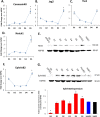Engineered Microvasculature in PDMS Networks Using Endothelial Cells Derived from Human Induced Pluripotent Stem Cells
- PMID: 28901188
- PMCID: PMC5680973
- DOI: 10.1177/0963689717720282
Engineered Microvasculature in PDMS Networks Using Endothelial Cells Derived from Human Induced Pluripotent Stem Cells
Abstract
In this study, we used a polydimethylsiloxane (PDMS)-based platform for the generation of intact, perfusion-competent microvascular networks in vitro. COMSOL Multiphysics, a finite-element analysis and simulation software package, was used to obtain simulated velocity, pressure, and shear stress profiles. Transgene-free human induced pluripotent stem cells (hiPSCs) were differentiated into partially arterialized endothelial cells (hiPSC-ECs) in 5 d under completely chemically defined conditions, using the small molecule glycogen synthase kinase 3β inhibitor CHIR99021 and were thoroughly characterized for functionality and arterial-like marker expression. These cells, along with primary human umbilical vein endothelial cells (HUVECs), were seeded in the PDMS system to generate microvascular networks that were subjected to shear stress. Engineered microvessels had patent lumens and expressed VE-cadherin along their periphery. Shear stress caused by flowing medium increased the secretion of nitric oxide and caused endothelial cells s to align and to redistribute actin filaments parallel to the direction of the laminar flow. Shear stress also caused significant increases in gene expression for arterial markers Notch1 and EphrinB2 as well as antithrombotic markers Kruppel-like factor 2 (KLF-2)/4. These changes in response to shear stress in the microvascular platform were observed in hiPSC-EC microvessels but not in microvessels that were derived from HUVECs, which indicated that hiPSC-ECs may be more plastic in modulating their phenotype under flow than are HUVECs. Taken together, we demonstrate the feasibly of generating intact, engineered microvessels in vitro, which replicate some of the key biological features of native microvessels.
Keywords: arterial; endothelial cells; human induced pluripotent stem cells (hiPSCs); microfluidics; microvessels; shear stress.
Conflict of interest statement
Figures







Similar articles
-
Characterisation of human induced pluripotent stem cell-derived endothelial cells under shear stress using an easy-to-use microfluidic cell culture system.Biomed Microdevices. 2017 Oct 9;19(4):91. doi: 10.1007/s10544-017-0229-5. Biomed Microdevices. 2017. PMID: 28994005
-
Reprogramming of Adult Peripheral Blood Cells into Human Induced Pluripotent Stem Cells as a Safe and Accessible Source of Endothelial Cells.Stem Cells Dev. 2018 Jan 1;27(1):10-22. doi: 10.1089/scd.2017.0132. Epub 2017 Dec 11. Stem Cells Dev. 2018. PMID: 29117787 Free PMC article.
-
Arterial specification of endothelial cells derived from human induced pluripotent stem cells in a biomimetic flow bioreactor.Biomaterials. 2015;53:621-33. doi: 10.1016/j.biomaterials.2015.02.121. Epub 2015 Mar 24. Biomaterials. 2015. PMID: 25890758 Free PMC article.
-
Human Induced Pluripotent Stem Cell-Derived Endothelial Cells for Three-Dimensional Microphysiological Systems.Tissue Eng Part C Methods. 2017 Aug;23(8):474-484. doi: 10.1089/ten.TEC.2017.0133. Tissue Eng Part C Methods. 2017. PMID: 28622076 Free PMC article.
-
Environmental Specification of Pluripotent Stem Cell Derived Endothelial Cells Toward Arterial and Venous Subtypes.Front Bioeng Biotechnol. 2019 Jun 14;7:143. doi: 10.3389/fbioe.2019.00143. eCollection 2019. Front Bioeng Biotechnol. 2019. PMID: 31259171 Free PMC article. Review.
Cited by
-
Analysis of adhesion kinetics of cancer cells on inflamed endothelium using a microfluidic platform.Biomicrofluidics. 2018 Jun 8;12(4):042215. doi: 10.1063/1.5025891. eCollection 2018 Jul. Biomicrofluidics. 2018. PMID: 29937953 Free PMC article.
-
Prevascularized Micro-/Nano-Sized Spheroid/Bead Aggregates for Vascular Tissue Engineering.Nanomicro Lett. 2021 Aug 18;13(1):182. doi: 10.1007/s40820-021-00697-1. Nanomicro Lett. 2021. PMID: 34409511 Free PMC article.
-
Skin-on-a-Chip Technology: Microengineering Physiologically Relevant In Vitro Skin Models.Pharmaceutics. 2022 Mar 21;14(3):682. doi: 10.3390/pharmaceutics14030682. Pharmaceutics. 2022. PMID: 35336056 Free PMC article. Review.
-
Whole-Transcriptome Sequencing: a Powerful Tool for Vascular Tissue Engineering and Endothelial Mechanobiology.High Throughput. 2018 Feb 21;7(1):5. doi: 10.3390/ht7010005. High Throughput. 2018. PMID: 29485616 Free PMC article. Review.
-
Bio-inspired microfluidics: A review.Biomicrofluidics. 2023 Sep 27;17(5):051503. doi: 10.1063/5.0161809. eCollection 2023 Sep. Biomicrofluidics. 2023. PMID: 37781135 Free PMC article. Review.
References
-
- Wells RG. The role of matrix stiffness in regulating cell behavior. Hepatology. 2008;47(4):1394–1400. - PubMed
-
- Lacorre DA, Baekkevold ES, Garrido I, Brandtzaeg P, Haraldsen G, Amalric F, Girard JP. Plasticity of endothelial cells: rapid dedifferentiation of freshly isolated high endothelial venule endothelial cells outside the lymphoid tissue microenvironment. Blood. 2004;103(11):4164–4172. - PubMed
Publication types
MeSH terms
Substances
Grants and funding
LinkOut - more resources
Full Text Sources
Other Literature Sources
Research Materials

